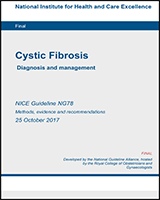NCBI Bookshelf. A service of the National Library of Medicine, National Institutes of Health.
Excerpt
Cystic fibrosis is a multi-system genetic disorder affecting the lungs, pancreas, liver and intestine. It can have a significant impact on life expectancy and quality of life. The current median age of those who have died is 28 years and the median predicted survival is 45.1 years.
Diagnosis is primarily made during newborn screening. The median age at diagnosis is 2 months and 1 in every 2500 babies born in the UK has cystic fibrosis. Approximately 60% of people on the UK CF registry are aged over 16 years.
Many different mutations are responsible for cystic fibrosis. The UK CF registry shows that 90.8% of people with cystic fibrosis have one known genotype. However 8.9% of people have at least one unknown genotype.
Lung function is often reduced in cystic fibrosis. The typical measure of lung function is forced expiratory volume in 1 second (FEV1). FEV1 is a key predictor of life expectancy in people with cystic fibrosis, and optimising lung function is a major goal of care.
Lung infections are a cause of significant morbidity in cystic fibrosis. Chronic infection (for example with Staphlococcus aureus and Pseudomonas aeruginosa) may need long-term use of antibiotics.
There is variation across the country in the multidisciplinary team structures used, the arrangements services make for providing care and in the resources available to support services. Particular problems may arise with smaller shared-care clinic arrangements. In some centres, both inpatient and outpatient facilities are limited. For example, there may be problems in arranging admission to single rooms with en-suite facilities. If adequate protocols are not in place, then there is a risk of cross-infection.
By making robust recommendations based on the available evidence and best practice in cystic fibrosis care, this guideline will help improve care for this highly complex condition.
Contents
- 1. Introduction
- 2. Guideline summary
- 3. Development of this guideline
- 4. Guideline development methodology
- 5. Diagnosis of cystic fibrosis
- 6. Information and Support
- 7. Service delivery
- 8. Complications of cystic fibrosis
- 8.1. Introduction
- 8.2. Malnutrition
- 8.3. Impaired growth
- 8.4. Cystic fibrosis related renal disease
- 8.5. Delayed puberty
- 8.6. Abdominal pain
- 8.7. Cystic Fibrosis related diabetes
- 8.8. Upper airways disease
- 8.9. Cystic fibrosis related musculoskeletal disorders
- 8.10. Urinary stress incontinence
- 8.11. Reduced bone mineral density
- 8.12. Cystic fibrosis related liver disease
- 8.13. Infertility
- 8.14. Distal Intestinal Obstruction Syndrome (DIOS)
- 8.15. Meconium ileus
- 8.16. Economic evidence
- 8.17. Evidence to recommendations
- 8.18. Recommendations
- 9. Pulmonary monitoring, assessment and management
- 10. Other monitoring, assessment and management
- 10.1. Nutritional Interventions
- 10.2. Exocrine pancreatic insufficiency
- 10.3. Distal intestinal obstruction syndrome
- 10.4. Monitoring for liver disease
- 10.5. Ursodeoxycholic acid
- 10.6. Monitoring for cystic fibrosis related diabetes
- 10.7. Monitoring for low bone mineral density
- 10.8. Exercise
- 10.9. Psychological assessment
- 11. Prevention of cross infection
- 12. References
- 13. Glossary and abbreviations
- Appendix A. Scope
- Appendix B. Stakeholders
- Appendix C. Declarations of interest
- Appendix D. Review protocols
- Appendix E. Search strategies
- Appendix F. Summary of identified studies
- Appendix G. Evidence tables
- Appendix H. Excluded studies
- Appendix I. Forest plots
- Appendix J. GRADE Tables
- Appendix K. Health Economics
- Appendix L. Health economics evidence tables
- Appendix M. Health economics quality assessment
- Appendix N. Network Meta-Analysis
Final
Developed by the National Guideline Alliance, hosted by the Royal College of Obstetricians and Gynaecologists
Disclaimer: The recommendations in this guideline represent the view of NICE, arrived at after careful consideration of the evidence available. When exercising their judgement, professionals are expected to take this guideline fully into account, alongside the individual needs, preferences and values of their patients or service users. The recommendations in this guideline are not mandatory and the guideline does not override the responsibility of healthcare professionals to make decisions appropriate to the circumstances of the individual patient, in consultation with the patient and/or their carer or guardian.
Local commissioners and/or providers have a responsibility to enable the guideline to be applied when individual health professionals and their patients or service users wish to use it. They should do so in the context of local and national priorities for funding and developing services, and in light of their duties to have due regard to the need to eliminate unlawful discrimination, to advance equality of opportunity and to reduce health inequalities. Nothing in this guideline should be interpreted in a way that would be inconsistent with compliance with those duties.
NICE guidelines cover health and care in England. Decisions on how they apply in other UK countries are made by ministers in the Welsh Government, Scottish Government, and Northern Ireland Executive. All NICE guidance is subject to regular review and may be updated or withdrawn.
- NLM CatalogRelated NLM Catalog Entries
- Cystic FibrosisCystic Fibrosis
Your browsing activity is empty.
Activity recording is turned off.
See more...
